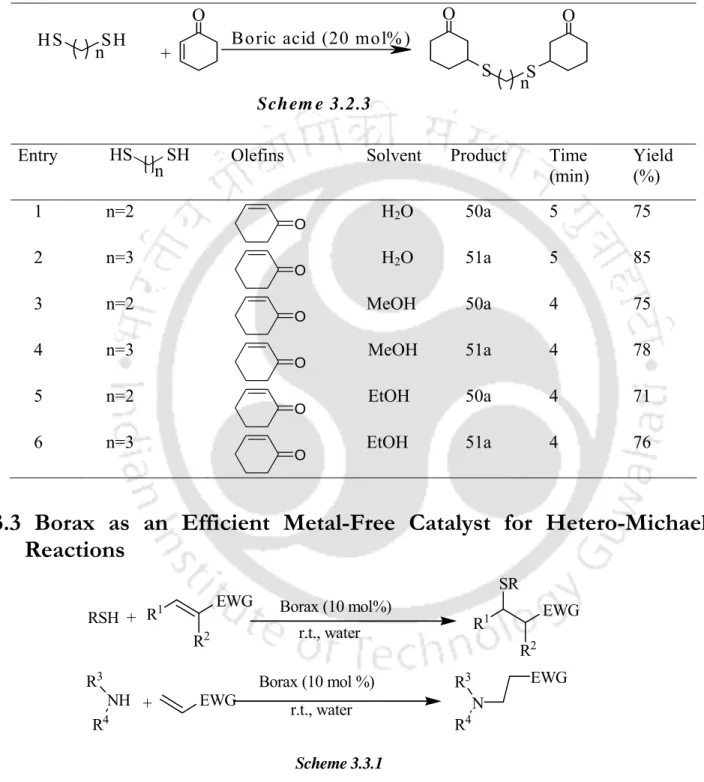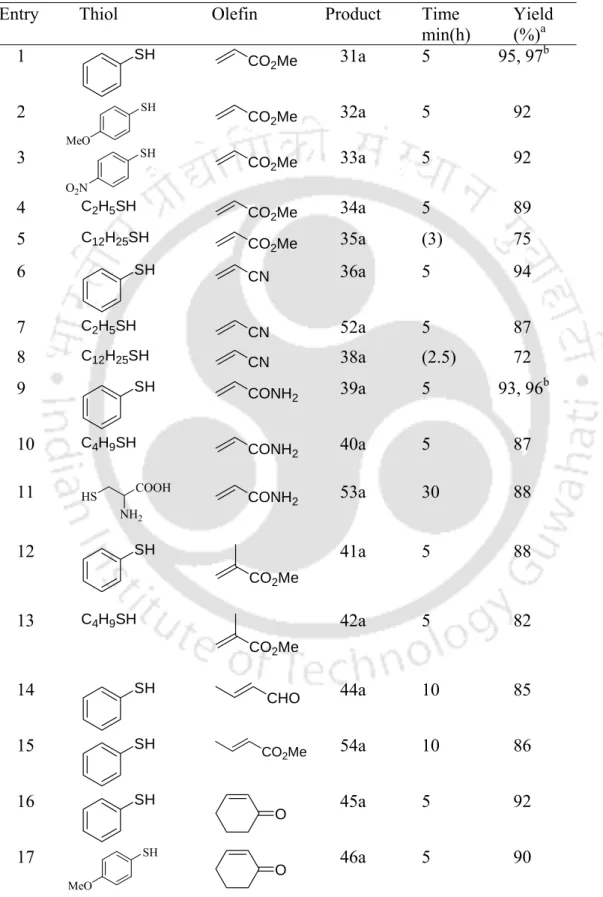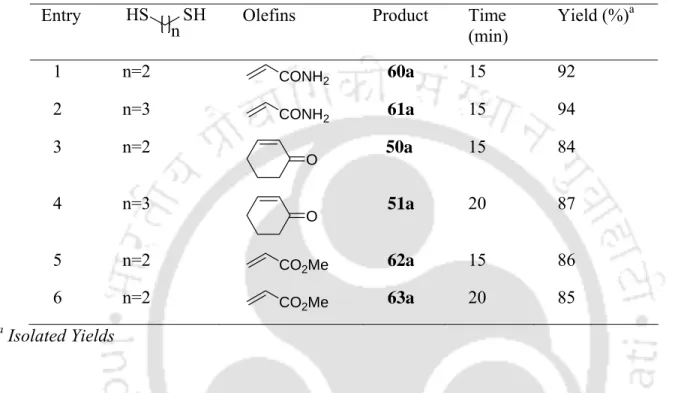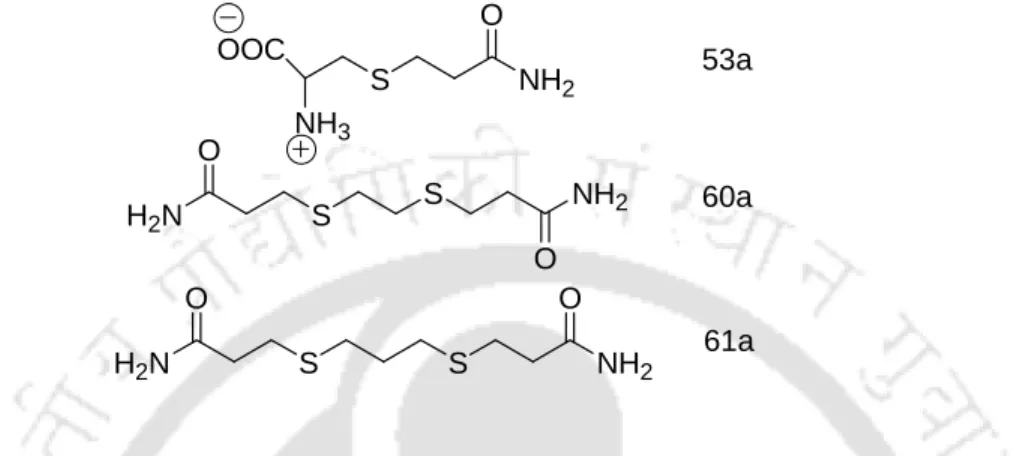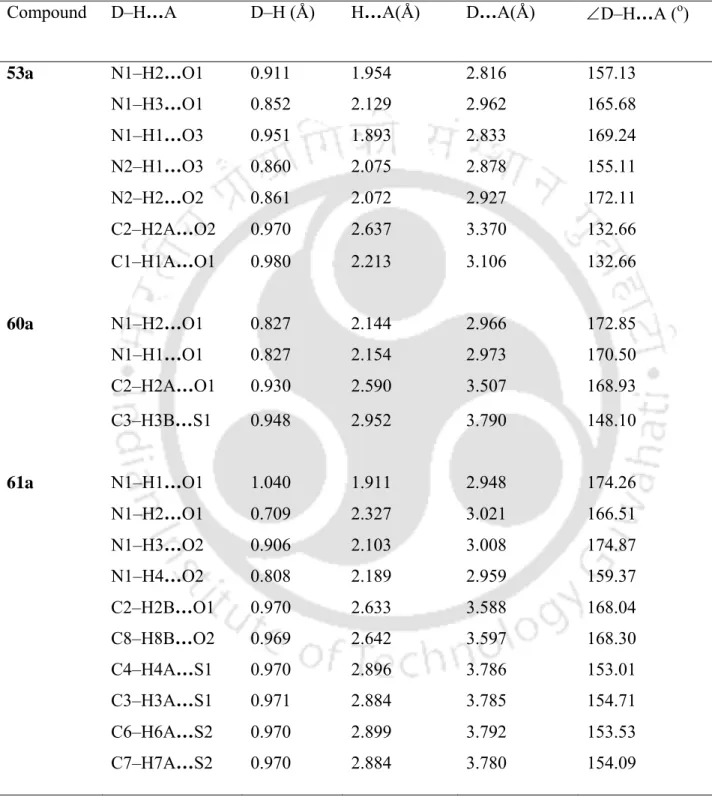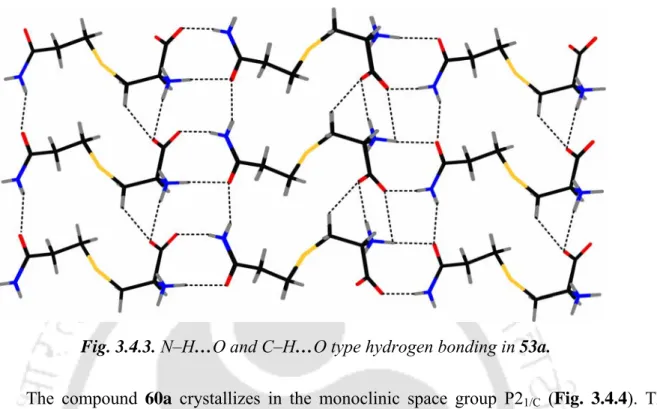I hereby declare that the matter included in this thesis is the result of research carried out by me in the Department of Chemistry, Indian Institute of Technology, Guwahati, India under the guidance of Professor Mihir K, Chaudhuri, FASc., FNA. The work is confirmed to be in a thesis entitled “Newer Catalytic Methodologies for C-N, C-S Bond Formation and Oxidation of Sulfides, Bromides and Alcohols with H2O2” by Sahid Hussain, a student in the Department of Chemistry, Indian Institute of Technology, Guwahati. for the award of the degree of Doctor of Philosophy was completed under my supervision and that this work was not submitted elsewhere for the degree.
Abstract
- gives a full account of our endeavour on aza- and thia-Michael reactions involving Cu(acac) 2 immobilized in ionic liquids (IL), boric acid in water and borax in water as the catalysts
- Introduction and Scope of Work in the Area
- Details of Materials, Methods and Equipment
- Catalytic Hetero-Michael Reactions
- Cu(acac) 2 Immobilized in Ionic Liquids: A Recoverable and Reusable Catalytic System for Aza-Michael Reactions
- Boric Acid: A Novel and Safe Metal-Free Catalyst for Aza- and Thia-Michael Reactions
- Borax as an Efficient Metal-Free Catalyst for Hetero-Michael Reactions Borax, a naturally occurring material, very efficiently catalyzes the conjugate addition of
- X-Ray Studies on β-Sulfidocarbonyls Evidencing Intermolecular Hydrogen Bonded Self-Assembled β-Pleated Sheet Structures
- Development of New Catalysts for Selective Oxidation of Sulfides with H 2 O 2
- Development of a New Catalyst [VO 2 F(dmpz) 2 ] for Oxidation of Organic Sulfides
- Borax and Phosphate Catalyzed Selective Oxidation of Organic Sulfides The selective oxidation of sulfides to sulfoxides and sulfones has been achieved in high
- VBrPO-Mimicking Catalysis in Water for Radical Bromination as well as Electrophillic Oxidation, and Oxidative Extraction of Bromide
- An Improved Synthesis of [K(V(O 2 ) 3 ].3H 2 O and its Use as a Precatalyst for Radical Bromination and Oxidation
- Microwave Assisted Synthesis of Quinolines
The use of boric acid, being a safe chemical substance, as the catalyst and water as the reaction medium are important features in the current protocol. The reaction can be carried out. The identity of the compound was established from the results of IR, UV and X-ray crystallography.
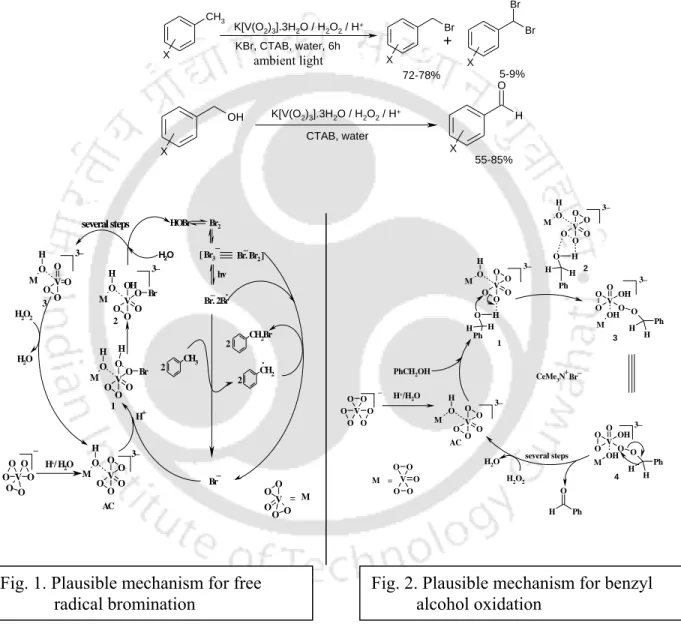
Introduction and Scope of Work
1A. Introduction
Finally, the massive increase in the use and expansion of the range of applications for polymeric supports in chemistry illustrate the tremendous importance of the techniques to chemists. One of the main reasons for the commercial importance of peroxo-complexes lies in the fact that the peroxide (O22-) is activated by a higher valence transition metal and some nonmetals making it suitable for effective oxidations.
1B. Scope of Work
Importantly, both solvents provide a pseudo-homogeneous reaction medium and enable easy recycling of the catalysts. Although some results have been published, manuscripts based on the rest are either in communication or in preparation.
1C. Reference
Whittaker (1997), Application of Microwaves to Organic Chemistry, [Online] Available at http://homepages.ed.ac.uk/ah05/ch1/c1org.htm (accessed 6 November 2003). Whittaker (1997), A Basic Introduction to Microwave Chemistry, [Online] Available at http://homepages.ed.ac.uk/ah05/microwave.html (accessed 5 November 2003).
Details of Materials, and Methods and Equipment
Detailed procedures for the preparation of various starting materials are described in this chapter. Also described herein are the details of the methods used for the quantitative determination of various constituents and relevant details of the instruments/equipment used for the characterization and structural assessment of the newly synthesized compounds.
2A. Preparation of starting materials
The addition of alkali was continued until the pH of the solution rose to ca. Distilled acetylacetone (11.06 mL, 110 mmol) was added to the precipitate and thoroughly mixed with a glass rod.
2B. Elemental analyses
SMART software was used for data collection, imaging indexing and determination of unit cell parameters. Crystal parameters for the compounds are presented in the experimental section of the respective chapters.
2D. Reference
Attached hydrogen atoms were fitted to difference Fourier maps and refined with isotropic displacement coefficients.
Newer Catalytic Hetero-Michael Reactions *
To our knowledge, the aza-Michael reactions involving a combination of the chosen catalyst and an ionic liquid were unprecedented while this work was being carried out. Relevantly, the β-sheet assembly is biochemically relevant to the understanding of the chemistry of natural and synthetic peptide analogs.
3A. Results and Discussions
Cu(acac) 2 Immobilized in Ionic Liquids: A Recoverable and Reusable Catalytic System for Aza-Michael Reactions
A variety of α,β-unsaturated carbonyl compounds or nitriles such as methyl acrylate, acrylonitrile, methyl vinyl ketone and cyclohexenone underwent 1,4-addition with a wide range of aliphatic amines in the presence of 2 mol% Cu(acac)2 in 1 ml ionic liquid at room temperature to obtain the corresponding β-amino compounds or nitriles in high yields in a very short time. Finally, upon completion of the reaction, the ionic liquid phase containing bmimBF4 and Cu(acac)2 was almost quantitatively recovered by simple extraction of the product with diethyl ether.
![Table 3.1.2. Cu(acac) 2 -catalyzed aza-Michael reaction of amines with α,β-unsaturated carbonyl compounds and nitriles in [bmim]BF 4](https://thumb-ap.123doks.com/thumbv2/azpdfnet/10458284.0/64.918.80.767.209.1097/table-catalyzed-michael-reaction-unsaturated-carbonyl-compounds-nitriles.webp)
Boric Acid: A Novel and Safe Metal-Free Catalyst for Aza- and Thia-Michael Reactions
Finally, after completion of the reaction, we examined the possibility of recycling the catalyst by a series of reactions with piperidine and methyl acrylate using an aqueous phase containing boric acid. Table 3.2.2. To extend the scope of the B(OH)3─water protocol, α- and β-substituted Michael acceptors were tested under the present conditions. Finally, after completion of the reaction, we checked the possibility of recycling the catalyst by a series of reactions with thiophenol and cyclohexenone using an aqueous phase containing boric acid.
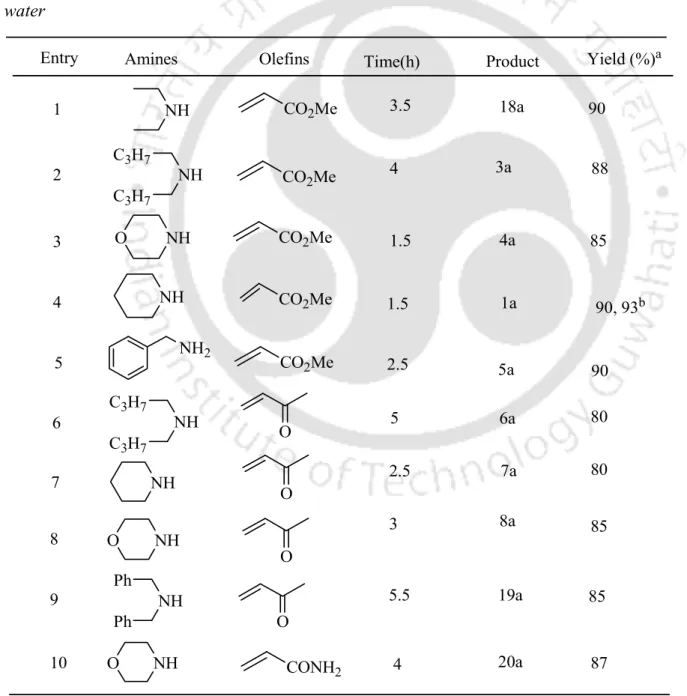
Borax as an Efficient Metal-Free Catalyst for Hetero-Michael Reactions
An internal comparison of thiol addition results and amine addition results under similar experimental conditions shows that the former are easier than the latter. Finally, we checked the possibility of recycling the catalyst by a series of reactions with thiophenol and methyl acrylate using an aqueous phase containing borax. It is also important to note that the borax-water protocol can be used in a relatively large scale (7 g) operation, giving very good yields (Table 3.3.4, entries 1 and 9).
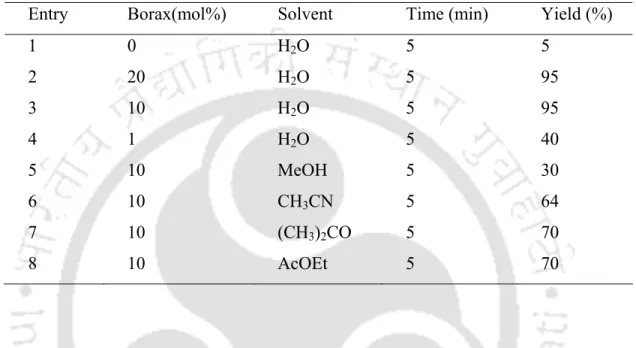
X-Ray Studies on β-Sulfidocarbonyls Evidencing Intermolecular Hydrogen Bonded Self-Assembled β -Pleated Sheet Structures
The stacking of wavy chains takes place along the crystallographic c-axis, where the interlayer connections are favored by hydrogen bonding (Table 3.4.1). It is thus quite clear that the crystal growth along the crystallographic c-axis involves head-to-head and tail-to-tail hydrogen bonding. The intermolecular connections along the crystallographic a-axis are established through the crystallographically nonequivalent reciprocal N–H…O hydrogen bond (N1–H1…O1 = 2,948 Å, N1–H4…O2 = 2,959 Å) (table 3.4.1) with normal strength.
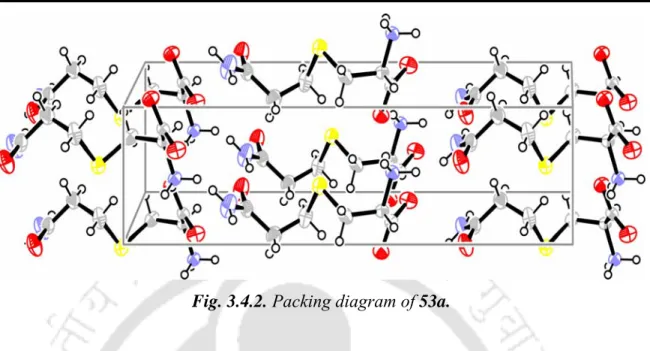
3B. Conclusion
As in 60a, the molecules in the crystals of 61a organize in such a way as to lead to the formation of a zig-zag hydrogen bond network.
3C. Experimental
The combined extracts (dried over Na 2 SO 4 ) were dried in vacuo and the resulting product was purified on silica gel (mesh size 60-120) with ethyl acetate and n-hexene (1:9 for thia and 3:7 for aza adduct) as eluent. to give the pure adduct. The precipitate was filtered and washed with water followed by recrystallization from MeOH or hot water.
3D. Characterization of the products
Spectra of some selected compounds
3E. Reference
At the moment, our interest was to develop a catalyst, for the selective oxidation of organic sulfides to the corresponding sulfoxides by H2O2, modeled after VBrPO. This in turn emphasizes that proton transfer would play an important role in peroxoborate oxidation of organic sulfides. Thus, (NH4)2HPO4–H2O2 has been shown to be an effective oxidizing system capable of selectively oxidizing a variety of organic sulfides to the corresponding sulfoxides.
4A. Results and Discussions
Borax and phosphate catalyzed selective oxidation of organic sulfides
This may be indicative of the fact that a higher concentration of diperoxoborates favors the formation of the sulfone over the corresponding sulfoxide. It may be mentioned that as the length of the alkyl sulfide chain increases, the reaction rate becomes slower. Catalyst recycling was examined through a series of reactions with methylphenyl sulfide using the aqueous phase containing borax obtained after extraction of the reaction mixture with EtOAc.
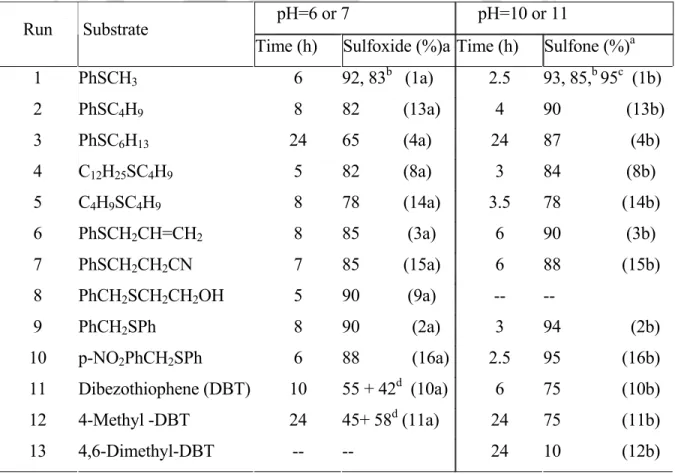
4B. Conclusion
A number of sulfides such as alkyl, aryl, and allyl sulfides were subjected to oxidation with (NH4)2HPO4 (10 mol%) in MeOH at room temperature to give the corresponding sulfoxides in high to very high yields (Table 4.2.4). Finally, after completion of the reaction, the aqueous phase containing phosphate was recycled for several cycles of uniform activity (5 cycles). A comparison of the results of sulphide oxidations with borax-H2O2 and [(NH4)2HPO4]-H2O shows that the former performs relatively better under the given experimental conditions.
4C. Experimental
Sample analysis was carried out by the Research and Development Department, Indian Oil Corporation Limited, Faridabad, India. 0.1 M NaOH was added to the resulting solution to maintain the pH of the solution at 6 or 7 or at 10 or 11, and the mixture was stirred at room temperature for the time indicated in Table 4.2.2. Na 2 SO 3 was added to the EtOAc extract to destroy any excess H 2 O 2 , if present, and then filtered and dried over anhydrous Na 2 SO 4 . The solvent of the pure fraction was evaporated, the product was completely dried and the isolated yield was recorded.
4D. Characterization of the products
4E. Reference
Myers, In Kirk-Othmer Encyclopedia of Chemical Technology, (Red.: J. I. Kroschwitz), Wiley-Interscience, New York, 1997, Vol.
VBrPO-Mimicking Catalysis in Water for Radical Bromination, Electrophillic Oxidation and
Besides radical bromination, the oxidation of alcohols to aldehydes or ketones is a fundamental transformation in the chemical industries. Therefore, we have developed an improved method for the synthesis of K[V(O2)3].3H2O and then investigated the benzylic bromination of toluene and the selective oxidation of benzyl alcohols with H2O2 as the final oxidant. The compound, [VO2F(dmpz)2] has been shown to efficiently and selectively catalyze the oxidation of bitter Br - by H2O2 in the presence of a small amount of acid.
5A. Results and Discussions
The hypothesis worked well with toluene and the reaction was optimized by varying the amount of H2O2 and the catalyst, K[V(O2)3].3H2O. We first examined different amounts of H2O2 for this oxidation reaction using 1.0 mol equiv of toluene, 0.1 mol equiv of catalyst, 1.2 equiv. The reaction was optimized with p-chlorobenzyl alcohol as a model substrate by changing the amount of H2O2 and the catalyst K[V(O2)3].3H2O.
![Fig. 5.1.1. The ORTEP view of K 3 [(O 2 ) 2 OV-(µ-OH)-VO(O 2 ) 2 ].H 2 O. K and H 2 O are removed for clarity](https://thumb-ap.123doks.com/thumbv2/azpdfnet/10458284.0/154.918.65.786.93.877/fig-ortep-view-ov-oh-vo-removed-clarity.webp)
5.2 [VO 2 F(dmpz) 2 ] catalyzed oxidative extraction of bromide from sea water
Oxidative extraction of bromide from 1 L bitters (24.5 mmol Br –) using VO2F(dmpz)2 as catalyst. Electron spectroscopy in solution appears to be an extremely important technique for the characterization of tribromides, as Br3– in solution has characteristic signatures at approx. Thus, the synthesis of tribromides described here not only provides easy access to such compounds, but also demonstrates the formation of Br3– in solution catalyzed by peroxovanadium intermediates.
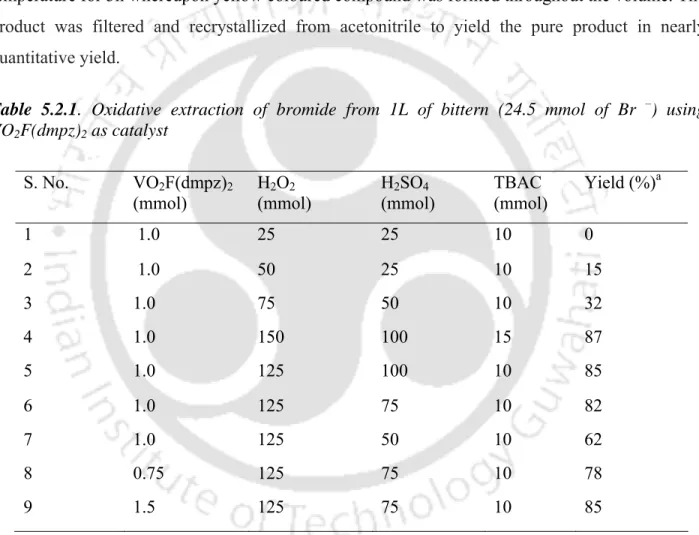
5B. Conclusion
5C. Experimental
The pH of the reaction mixture was adjusted to 5 or 4 using dilute H2SO4 and stirred in the ambient light at room temperature for the time given in Table 5.1.2. The reaction was monitored by GC MS and TLC and after completion of the reaction the product was extracted with hexane (2 x 5 mL). The reaction mixture was stirred for 3 hours after which an orange-yellow colored compound was formed throughout the volume.
5D. Characterization of the products
2.8 g (10.62 mmol) of tetrabutylammonium chloride (TBAC) or benzyltriethylammonium chloride (BTEAC) and 16 mL of 5M sulfuric acid (H2SO4) were added to the solution. This was allowed to settle and the compound was filtered off with suction and dried in a vacuum desiccator using anhydrous calcium chloride (CaCl2) as the drying agent.
![Table 5D.2. Bond lengths [Å] for K 3 [(O 2 ) 2 OV-(µ-OH)-VO(O 2 ) 2 ]H 2 O V(1)-O(5) 2.006(3) V(2)-O(1) 1.885(3)](https://thumb-ap.123doks.com/thumbv2/azpdfnet/10458284.0/168.918.61.782.132.1043/table-bond-lengths-å-for-ov-oh-vo.webp)
5E. Reference
An Efficient Synthesis of Quinolines under Solvent-free Conditions *
Quinoline derivatives have been well known not only in medicinal chemistry, due to their wide occurrence in natural products1,2 and pharmaceuticals,3,4, but also in polymer chemistry, electronics and optoelectronics for their excellent mechanical properties.5-7 Diblock- and triblock- copolymers Incorporation of polyquinoline blocks has been shown to undergo hierarchical self-assembly into a variety of nano- and mesostructures with interesting electronic and photonic functions.8,9 The Friedländer synthesis of quinolines is a classic method10 that involves two steps in which reduction of o -nitroarylaldehyde is obtained first followed by condensation of enolizable carbonyl compound in the presence of a Brønsted or Lewis acid catalyst (Scheme 6.1). In addition, there is a very recent report by Perumal et al.45 on the synthesis of polysubstituted quinolines under solvent-free conditions with some advantages over many other protocols. This chapter demonstrates an efficient solvent-free one-pot synthesis of quinolines obtained from o-nitrobenzaldehyde and enolizable ketones by using SnCl2.2H2O and exposing them to microwaves (Scheme 6.2).
6A. Results and Discussions
Therefore, it is very urgent that the synthesis of quinolines requires further attention to avoid the need to maintain strict experimental conditions, the use of expensive catalysts, and the preparation and isolation of o-amino carbonyls as synthetic precursors. In each case, a very small amount (1–3%) of the quinoline derivative was isolated, leading us to postulate that, under the given experimental conditions, microwave irradiation was responsible for initiating the reaction. The results show that alkyl and cycloalkyl enolizing ketones readily cyclize with in situ generated o-amino benzaldehyde to afford the corresponding quinolines in good to very good yields.
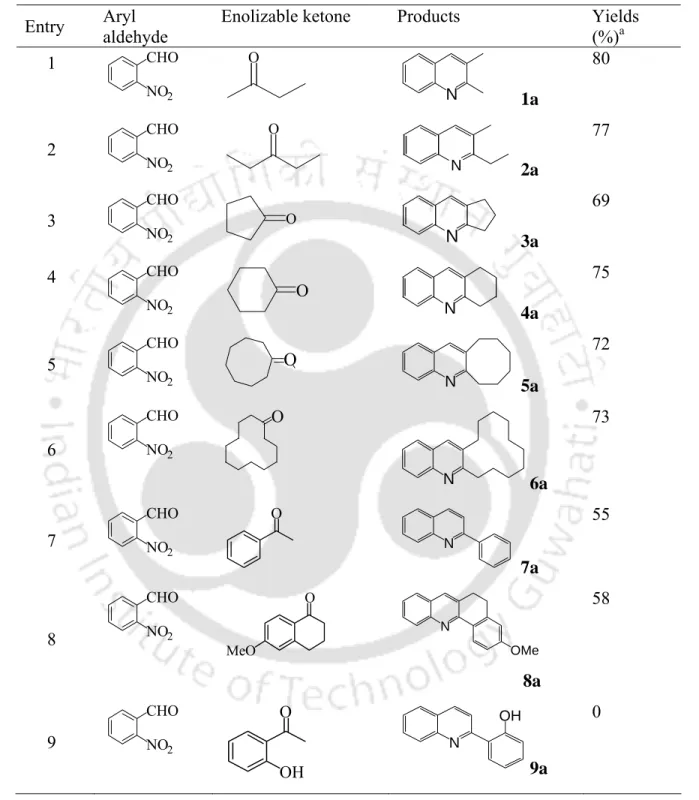
6B. Conclusion
6C. Experimental
6D. Characterization of the products
6E. Reference
Cu(acac)2 immobilized in ionic liquids: A recoverable and reusable catalytic system for aza-Michael reactions. Barbier Coupling in Water: SnCl2-Mediated and Co(acac)2-Catalyzed Allylation of Carbonyls Tetrahedron Lett. Borax as an efficient metal-free catalyst for hetero-Michael reactions in aqueous medium, Eur.

